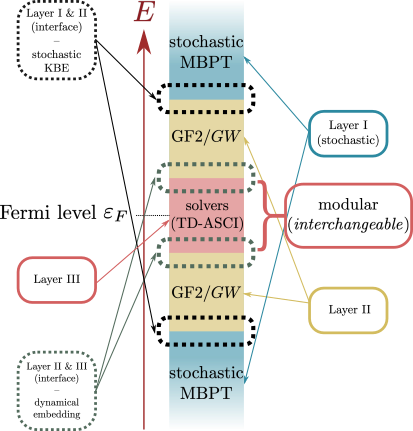Non-equilibrium strong field effects are at the forefront of the development of new materials for applications ranging from femtosecond state switching in traditional optoelectronic devices to novel quantum information platforms. Control of quantum states and their couplings to the environment is a new frontier in fundamental and applied physics, chemistry, and engineering. Future development, enhancement, and use of these systems hinges upon understanding and accurately predicting the dynamics of the individual electronic states under non-equilibrium conditions.
The interdisciplinary Partnership with SciDAC-5 institutes FASTMath and RAPIDS2 develops an embedding framework to capture non-equilibrium dynamics. The resulting paradigm will directly overcome many of the limitations that hinder the computational studies of realistic and practically relevant energy and quantum materials out-of-equilibrium. Crucially, the proposed methodology is based on state-of-the-art first principles (i.e., without empirical parameters) quantum theory.
This project tackles the computational hurdle by developing novel numerical techniques, and combine them with neural network approaches and efficient multiscale embedding. The unique framework is based on connecting stochastic (Layer I), deterministic (Layer II), and explicitly correlated (Layer III) methods.
The most extensive part of the calculation (Layer I) is accomplished using the many-body perturbation theory combined with a statistical sampling of single-particle states and operators. This revolutionary stochastic approach enables treating systems with thousands of atoms. Layer II is based on an accurate deterministic implementation which provides a necessary transition to Layer III treated by (numerically exact) many-body calculations (i.e., beyond the perturbation theory).
The framework exploits the capabilities of DOE's flagship computing architectures and addresses the non-equilibrium properties of systems with thousands of atoms. The new suite of tools will enable studying time-dependent problems that are at least two orders of magnitude larger in spatial and temporal dimensions than those treatable by the most advanced present algorithms.
Schematics of the embedding scheme based on a combination of stochastic, perturbative and explicitly correlated many-body methods.

The methodology is validated and verified on bulk semiconductors and insulators, ranging from molecules and conventional (3D periodic) phases to correlated 2D low dimensional materials which exhibit novel excited state phenomena. The practical calculations will investigate both the efficiency of the embedding as well as the time evolution of the quantum states (and associated numerical stability of the mathematical treatments).
This Partnership will produce efficient and scalable open-source software and practical procedures available to the research community and impact a wide range of areas in chemistry, physics, materials science, and applied mathematics. These tools enable a direct connection between theory, computations, and ultrafast experimental techniques for the characterization of transient quantum properties. In particular, this Partnership will facilitate research on systems for quantum information and sensing, photonics, and ultrafast electronics. .
Objectives
Development of an embedding framework for simulating the transition from equilibrium to transient states, with strong driving or ultrafast pulses, capturing electronic dynamics as, e.g., in time-resolved photoemission and pump-probe spectroscopy. The embedding will employ deterministic and stochastic approaches combined with advanced methods for correlated electrons.
Development of modular computational tools (codes, libraries, and algorithms) through a flexible framework for continued development and expansion. They will enable simulating 100,000 weakly correlated electrons with real-time stochastic many-body perturbation theory, efficiently linked with current and future solvers for strongly correlated states.
